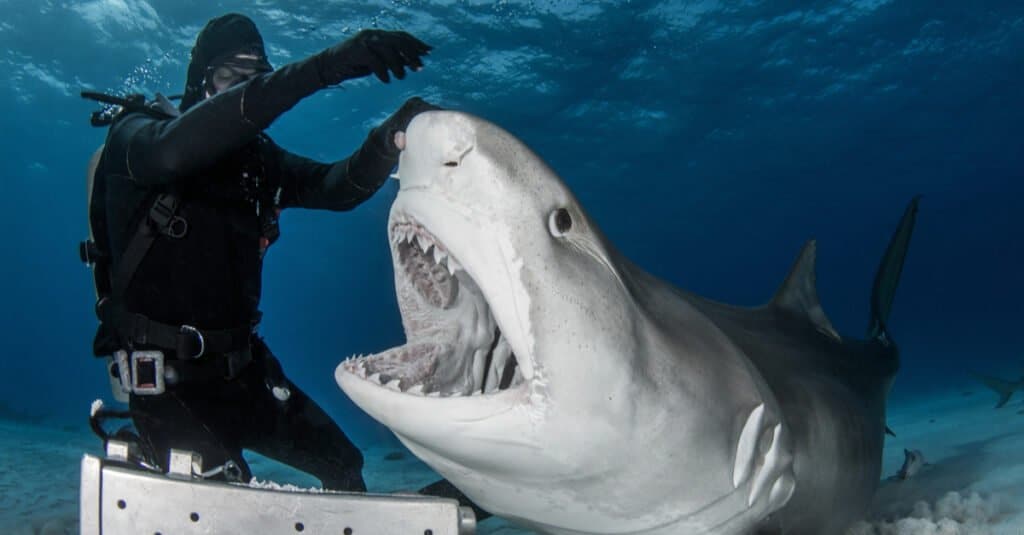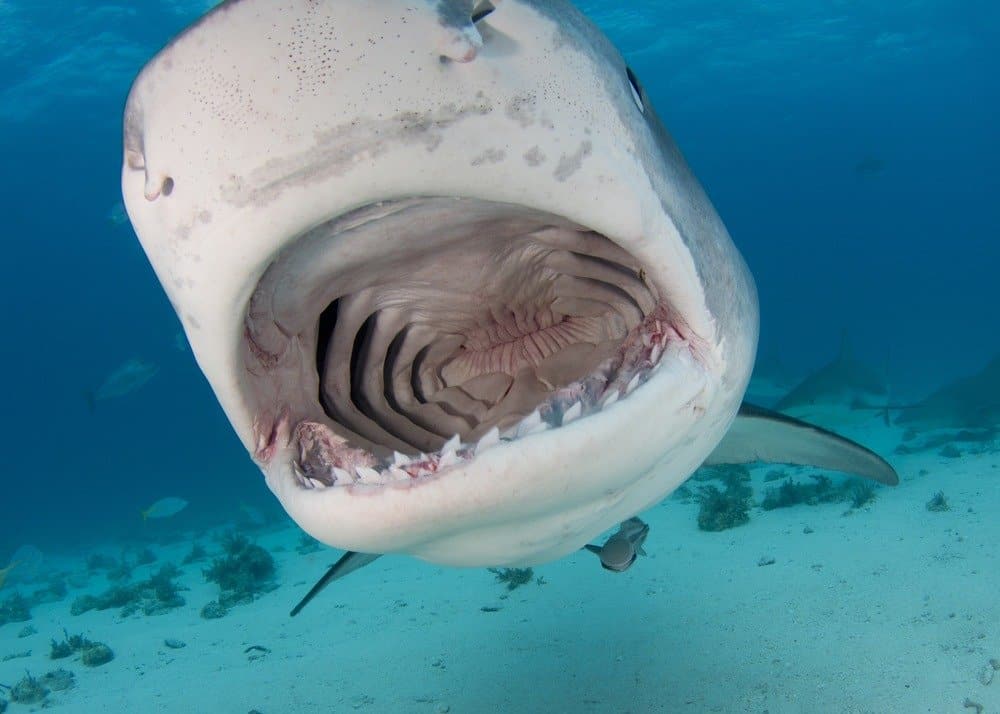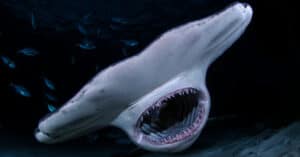10 Mind-Blowing Tiger Shark Facts!
Tiger sharks are fierce predators who will eat just about anything. These incredible animals hold a lot of secrets, including the one who had a murder mystery hidden in its stomach! From their ginormous size to the unusual development of their offspring, you’re bound to learn something new in this list of 10 mind-blowing tiger shark facts.
1. Tiger Sharks can Weigh over 1700 Pounds!

Tomas Kotouc/Shutterstock.com
Tiger sharks are the second largest predator shark in the world, and the fourth largest shark overall. They typically weigh between 850-1400 pounds, but the largest tiger sharks have weighed in at over 1,700 pounds.
These large creatures can also reach lengths of over 18 feet!
2. Mama Tiger Sharks Give Live Birth—but Babies Develop in Eggs
Most animals who give live birth have a placenta that “feeds” their offspring the nutrients they need while inside of the uterus.
Tiger sharks don’t develop placenta. Instead, the babies each grow inside of their own egg. Once the babies hatch, mama tiger shark gives birth to the live offspring.
3. A Tiger Shark Will Eat Anything!

Matt9122/Shutterstock.com
Tiger sharks are the Labradors of the ocean world. While they have preferred foods, tiger sharks will eat anything from their variety of natural prey to their own offspring or trash that has been dumped into the ocean.
It’s important to keep our oceans clean for these “ocean puppers” who eat like teething puppies!
When animals eat materials such as plastic, it’s introduced into our food chain, which is detrimental to us all in the long run.
4. No Really, Anything—Even Severed Human Limbs!
Here’s a wild story—a tiger shark captured from the wild once threw up a human arm inside of a Sydney aquarium!
It was first assumed that the shark had bitten off someone’s arm during an attack, but police would later learn that it had been cut off by a sharp object.
Boxer James Smith had a distinctive tattoo on his left arm, and so it was quickly traced back to him. He was also a police informant who did business with several criminals as part of his work.
Suspects were arrested, but with just one arm as evidence, it was difficult to try them for murder. In the end, suspect Reginald Holmes was murdered.
Because Holmes was a key witness for the other suspect, John Brady’s, trial, Brady was able to walk away without facing charges. There simply wasn’t enough evidence that he was involved in either crime.
Unfortunately, this happened in 1935 when marine animal care didn’t have very high standards. The shark died in captivity.
No other body parts belonging to Jimmy Smith were ever found.
5. They’ll Brave a Hurricane for a Good Meal
When we say tiger sharks are food motivated, we really do mean it! They’ve been found to brave harsh storms, perhaps using them as hunting opportunities.
Scientists tracked four shark species from 2016-2017. Three of these species fled from a hurricane, but the tiger sharks remained in place.
In the weeks following Hurricane Irma, they noticed even more tiger sharks in the waters than there had been before the storm.
One of the scientists, Neil Hammerschlag, believes that the sharks’ size might have something to do with it. They were the largest shark that the researchers tracked in the study, and may have been better equipped to withstand harsh waters than the other species.
He also speculated that the sharks might have taken the opportunity to scavenge dead animal carcasses, which would be increasingly available during the storm.
6. They’re Expert Gardeners
Okay, so tiger sharks don’t necessarily tend to the ocean’s plants—but they do scare away grazers who eat sea grass!
The sea grass in Australia’s Shark Bay was in ruins after a heat wave in 2011, but it’s gradually grown back. Restoration happens more quickly when tiger sharks are around, since they’re one of the only sharks to eat sea turtles.
Their presence is enough to scare them, and potentially other animals, away from the grass so that it can grow.
7. They can Have up to 80 Babies!
What a large family! Unfortunately, you won’t see them gathering for the next family reunion anytime soon.
Baby sharks are prey for adult Tiger Sharks, but luckily they thrive in different habitats. Baby sharks stick to calmer areas, such as river mouths or bays, where they can feed on small prey.
Adults are large enough to swim in harsher waters, where the food sources are also larger and more diverse.
The tiger shark and its many offspring stand in stark contrast to sand tiger sharks, a different shark species whose offspring eat one another in the womb! Only the strongest is able to survive.
Tiger sharks and sand tigers are often confused for one another due to their very similar names.
8. They’re Among the Many Animals Who Seem to Have it out for this Man
In 2018, Dylan McWilliams was only 20 years old. He’d already been attacked by a snake, a bear, and a tiger shark!
He first felt the shark brush his leg, when he began to kick at it and swim away. He says he knew he’d been bitten because he left behind blood in the water.
Dylan needed seven stitches in his leg, but luckily survived the attack.
The bear attack happened while he was sleeping on a camping trip, and the rattlesnake bite occurred in 2015 while Dylan was hiking.
We sure hope his luck has improved since these encounters!
9. Tiger Sharks Migrate for the Winter like Birds
Tiger sharks prefer warm waters. Their ideal temperatures rests around 71 degrees Fahrenheit (22 degrees Celsius).
When the water starts to cool in the winter, the sharks head toward tropical areas to keep warm. In the summer, they return to slightly cooler waters to maintain their ideal habitat.
10. They’re at the Top of the Food Chain
Tiger sharks have no natural predators aside from humans, who have been known to kill them for their skin, fins, flesh, and oil. They’re also hunted recreationally.
When it comes to ocean life, the only thing that tends to kill tiger sharks is, well, other tiger sharks! And the occasional killer whale attack.
They routinely eat smaller sharks, including their own offspring. This is one reason why they live mostly separate, with babies feasting on small prey like fish, jellyfish, or mollusks in calmer waters while adults brave harsher conditions with more abundant prey.
More from A-Z Animals
Tiger sharks are fierce predators who will eat just about anything. These incredible animals hold a lot of secrets, including the one who had a murder mystery hidden in its stomach! From their ginormous size to the unusual development of their offspring, you’re bound to learn something new in this list of 10 mind-blowing tiger shark facts.
1. Tiger Sharks can Weigh over 1700 Pounds!

Tomas Kotouc/Shutterstock.com
Tiger sharks are the second largest predator shark in the world, and the fourth largest shark overall. They typically weigh between 850-1400 pounds, but the largest tiger sharks have weighed in at over 1,700 pounds.
These large creatures can also reach lengths of over 18 feet!
2. Mama Tiger Sharks Give Live Birth—but Babies Develop in Eggs
Most animals who give live birth have a placenta that “feeds” their offspring the nutrients they need while inside of the uterus.
Tiger sharks don’t develop placenta. Instead, the babies each grow inside of their own egg. Once the babies hatch, mama tiger shark gives birth to the live offspring.
3. A Tiger Shark Will Eat Anything!

Matt9122/Shutterstock.com
Tiger sharks are the Labradors of the ocean world. While they have preferred foods, tiger sharks will eat anything from their variety of natural prey to their own offspring or trash that has been dumped into the ocean.
It’s important to keep our oceans clean for these “ocean puppers” who eat like teething puppies!
When animals eat materials such as plastic, it’s introduced into our food chain, which is detrimental to us all in the long run.
4. No Really, Anything—Even Severed Human Limbs!
Here’s a wild story—a tiger shark captured from the wild once threw up a human arm inside of a Sydney aquarium!
It was first assumed that the shark had bitten off someone’s arm during an attack, but police would later learn that it had been cut off by a sharp object.
Boxer James Smith had a distinctive tattoo on his left arm, and so it was quickly traced back to him. He was also a police informant who did business with several criminals as part of his work.
Suspects were arrested, but with just one arm as evidence, it was difficult to try them for murder. In the end, suspect Reginald Holmes was murdered.
Because Holmes was a key witness for the other suspect, John Brady’s, trial, Brady was able to walk away without facing charges. There simply wasn’t enough evidence that he was involved in either crime.
Unfortunately, this happened in 1935 when marine animal care didn’t have very high standards. The shark died in captivity.
No other body parts belonging to Jimmy Smith were ever found.
5. They’ll Brave a Hurricane for a Good Meal
When we say tiger sharks are food motivated, we really do mean it! They’ve been found to brave harsh storms, perhaps using them as hunting opportunities.
Scientists tracked four shark species from 2016-2017. Three of these species fled from a hurricane, but the tiger sharks remained in place.
In the weeks following Hurricane Irma, they noticed even more tiger sharks in the waters than there had been before the storm.
One of the scientists, Neil Hammerschlag, believes that the sharks’ size might have something to do with it. They were the largest shark that the researchers tracked in the study, and may have been better equipped to withstand harsh waters than the other species.
He also speculated that the sharks might have taken the opportunity to scavenge dead animal carcasses, which would be increasingly available during the storm.
6. They’re Expert Gardeners
Okay, so tiger sharks don’t necessarily tend to the ocean’s plants—but they do scare away grazers who eat sea grass!
The sea grass in Australia’s Shark Bay was in ruins after a heat wave in 2011, but it’s gradually grown back. Restoration happens more quickly when tiger sharks are around, since they’re one of the only sharks to eat sea turtles.
Their presence is enough to scare them, and potentially other animals, away from the grass so that it can grow.
7. They can Have up to 80 Babies!
What a large family! Unfortunately, you won’t see them gathering for the next family reunion anytime soon.
Baby sharks are prey for adult Tiger Sharks, but luckily they thrive in different habitats. Baby sharks stick to calmer areas, such as river mouths or bays, where they can feed on small prey.
Adults are large enough to swim in harsher waters, where the food sources are also larger and more diverse.
The tiger shark and its many offspring stand in stark contrast to sand tiger sharks, a different shark species whose offspring eat one another in the womb! Only the strongest is able to survive.
Tiger sharks and sand tigers are often confused for one another due to their very similar names.
8. They’re Among the Many Animals Who Seem to Have it out for this Man
In 2018, Dylan McWilliams was only 20 years old. He’d already been attacked by a snake, a bear, and a tiger shark!
He first felt the shark brush his leg, when he began to kick at it and swim away. He says he knew he’d been bitten because he left behind blood in the water.
Dylan needed seven stitches in his leg, but luckily survived the attack.
The bear attack happened while he was sleeping on a camping trip, and the rattlesnake bite occurred in 2015 while Dylan was hiking.
We sure hope his luck has improved since these encounters!
9. Tiger Sharks Migrate for the Winter like Birds
Tiger sharks prefer warm waters. Their ideal temperatures rests around 71 degrees Fahrenheit (22 degrees Celsius).
When the water starts to cool in the winter, the sharks head toward tropical areas to keep warm. In the summer, they return to slightly cooler waters to maintain their ideal habitat.
10. They’re at the Top of the Food Chain
Tiger sharks have no natural predators aside from humans, who have been known to kill them for their skin, fins, flesh, and oil. They’re also hunted recreationally.
When it comes to ocean life, the only thing that tends to kill tiger sharks is, well, other tiger sharks! And the occasional killer whale attack.
They routinely eat smaller sharks, including their own offspring. This is one reason why they live mostly separate, with babies feasting on small prey like fish, jellyfish, or mollusks in calmer waters while adults brave harsher conditions with more abundant prey.






